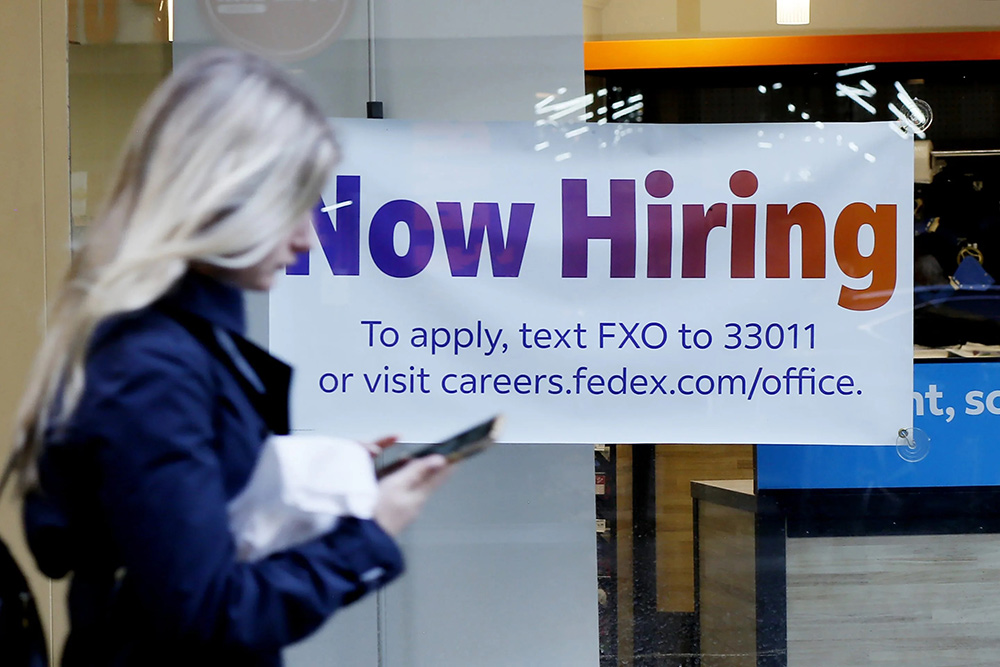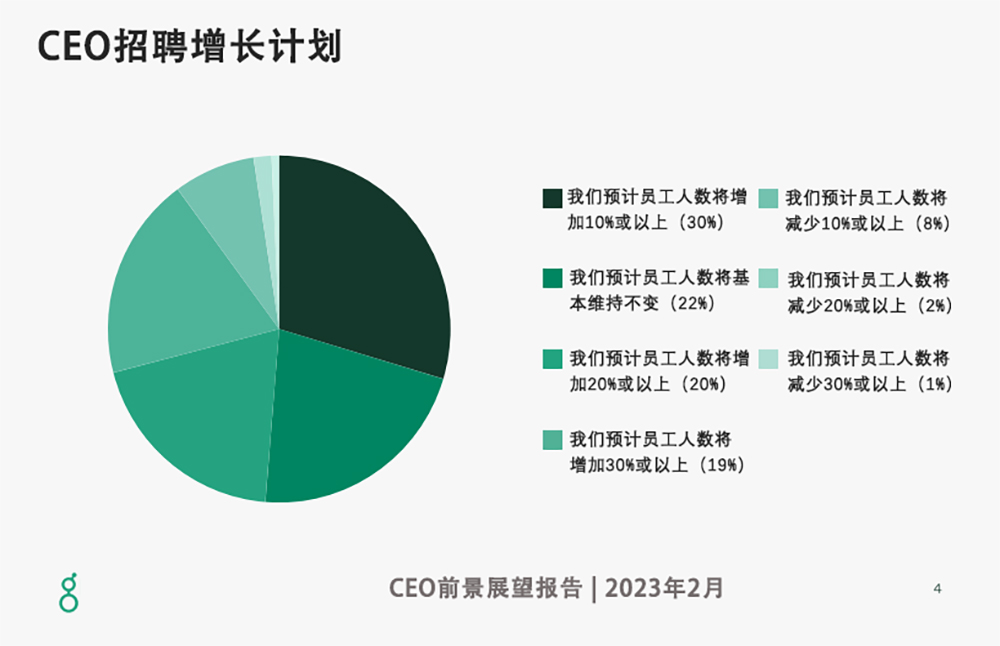
随着各国央行纷纷利用加息应对高通胀,CEO们都对经济前景感到担忧。但奇怪的是,他们却依旧在进行招聘。Greenhouse最近调查发现,约68%的首席执行官今年计划增加公司员工人数。在该数据发布之前,美国经济在1月份新增就业517,000个,是经济学家预测的一倍以上,而失业率降至3.4%,为53年最低水平。
在最新就业报告公布之前,科技行业的大规模裁员,使劳动力市场呈现出一片更加惨淡的景象。2022年,随着曾经高歌猛进的科技股暴跌,有超过150,000名科技工作者失业,在过去12个月,仅大型科技公司的裁员人数就超过了70,000人。
与此同时,在安永(EY)1月份的调查中,约98%的首席执行官表示“正在为经济下滑做准备”,有55%的受访者承认,他们正在准备迎接“比全球金融危机更严重的”情况。尽管他们担心经济衰退,而且科技行业哀鸿遍野,但大多数公司依旧没有裁员计划。
在Greenhouse的调查中,只有11%的CEO表示今年计划裁员。约三分之一CEO计划增加员工10%或以上,有19%的CEO计划增加30%以上。

1月普华永道(PwC)对全球4,410位CEO的调查,在招聘计划方面也发现了类似的现象。CEO们对经济状况表示谨慎,有52%的CEO表示今年计划削减成本。但与此同时,留住人才依旧是他们的首要任务。
在普华永道的调查中,只有19%的CEO表示将停止招聘,只有16%的CEO计划裁员。
普华永道研究人员表示:“这与我们在2008年10月和11月对CEO们的调查结果形成鲜明对比。当时,预计近期裁员的CEO比例约是本次调查结果的两倍之多。”
世界大型企业联合会(Conference Board)的研究人员在1月的“企业高管前景展望”中,根据全球1,131名高管的回复发现,虽然经济衰退是CEO们最担心的“外部”问题,但在紧张的劳动力市场吸引和留住人才,却是最紧迫的“内部”问题。
世界大型企业联合会首席经济学家达纳·皮特森在一份声明中表示:“虽然全球CEO都计划削减成本和减少非必要支出,这些都是在经济下滑时期通常采取的措施,但员工可以长舒一口气,因为很少有CEO计划裁员。相反,他们降低风险的计划是,加快创新和数字化转型,挖掘更高增长市场中的机会,以及调整公司的经营模式,这是被提及最多的三项措施。”(财富中文网)
译者:刘进龙
审校:汪皓
随着各国央行纷纷利用加息应对高通胀,CEO们都对经济前景感到担忧。但奇怪的是,他们却依旧在进行招聘。Greenhouse最近调查发现,约68%的首席执行官今年计划增加公司员工人数。在该数据发布之前,美国经济在1月份新增就业517,000个,是经济学家预测的一倍以上,而失业率降至3.4%,为53年最低水平。
在最新就业报告公布之前,科技行业的大规模裁员,使劳动力市场呈现出一片更加惨淡的景象。2022年,随着曾经高歌猛进的科技股暴跌,有超过150,000名科技工作者失业,在过去12个月,仅大型科技公司的裁员人数就超过了70,000人。
与此同时,在安永(EY)1月份的调查中,约98%的首席执行官表示“正在为经济下滑做准备”,有55%的受访者承认,他们正在准备迎接“比全球金融危机更严重的”情况。尽管他们担心经济衰退,而且科技行业哀鸿遍野,但大多数公司依旧没有裁员计划。
在Greenhouse的调查中,只有11%的CEO表示今年计划裁员。约三分之一CEO计划增加员工10%或以上,有19%的CEO计划增加30%以上。
1月普华永道(PwC)对全球4,410位CEO的调查,在招聘计划方面也发现了类似的现象。CEO们对经济状况表示谨慎,有52%的CEO表示今年计划削减成本。但与此同时,留住人才依旧是他们的首要任务。
在普华永道的调查中,只有19%的CEO表示将停止招聘,只有16%的CEO计划裁员。
普华永道研究人员表示:“这与我们在2008年10月和11月对CEO们的调查结果形成鲜明对比。当时,预计近期裁员的CEO比例约是本次调查结果的两倍之多。”
世界大型企业联合会(Conference Board)的研究人员在1月的“企业高管前景展望”中,根据全球1,131名高管的回复发现,虽然经济衰退是CEO们最担心的“外部”问题,但在紧张的劳动力市场吸引和留住人才,却是最紧迫的“内部”问题。
世界大型企业联合会首席经济学家达纳·皮特森在一份声明中表示:“虽然全球CEO都计划削减成本和减少非必要支出,这些都是在经济下滑时期通常采取的措施,但员工可以长舒一口气,因为很少有CEO计划裁员。相反,他们降低风险的计划是,加快创新和数字化转型,挖掘更高增长市场中的机会,以及调整公司的经营模式,这是被提及最多的三项措施。”(财富中文网)
译者:刘进龙
审校:汪皓
With central banks worldwide raising interest rates to fight high inflation, CEOs are worried about the economy. But oddly enough, they’re still hiring. Some 68% of chief executives plan to increase their company’s headcount this year, according to a new Greenhouse survey. The data comes after the U.S. economy added 517,000 jobs in January—more than double economists’ forecasts—and the unemployment rate fell to a 53-year low of 3.4%.
Before the latest jobs report, a drumbeat of tech industry layoffs painted a much darker picture of the labor market. Over 150,000 tech workers lost their jobs in 2022 as once-high-flying tech stocks tumbled, and Big Tech companies alone have now shed over 70,000 employees in the past 12 months.
At the same time, some 98% of chief executives said they are “bracing for an economic downturn” in a January EY survey—with 55% admitting they’re preparing for something “worse than the global financial crisis.” But despite the recession fears and tech industry woes, layoffs still aren’t in the cards for most companies.
In the Greenhouse survey, just 11% of CEOs said they expect to reduce their firm’s headcount this year. And roughly a third of chief execs plan to increase their headcount by 10% or more, while 19% plan a 30%-plus increase.
A January PwC survey of 4,410 CEOs from around the world found a similar phenomenon in hiring plans. CEOs are cautious about the economy, and 52% said they plan to cut costs this year. But at the same time, retaining talent remains a top priority.
Only 19% of CEOs said in PwC’s survey that they were implementing hiring freezes, and just 16% planned to reduce their company’s headcount.
“This stands in stark contrast to what we heard from CEOs back in October and November of 2008, when about twice as many told us they anticipated near-term headcount reductions,” the PwC researchers noted.
Conference Board researchers also found in their January C-Suite Outlook, based on responses from 1,131 executives worldwide, that although a recession was the top “external” concern among CEOs, attracting and retaining talent in a tight labor market was the most pressing “internal” concern.
“While CEOs globally are looking to contain costs and reduce discretionary spending—actions typically taken during a slowdown—employees may be able to breathe a sigh of relief, as few executives are turning to layoffs,” Dana Peterson, chief economist of the Conference Board, explained in a statement. “Instead, they plan to mitigate risk by accelerating innovation and digital transformation, pursuing new opportunities in higher-growth markets, and revising business models—the three most-cited actions.”






